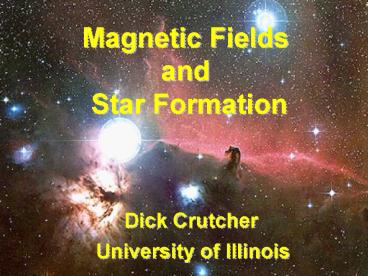Magnetic Fields and - PowerPoint PPT Presentation
1 / 24
Title:
Magnetic Fields and
Description:
Tests of star formation theory. Observations. Techniques. Exemplars observational results ... ambipolar diffusion driving star formation, on a fast (~few free ... – PowerPoint PPT presentation
Number of Views:23
Avg rating:3.0/5.0
Title: Magnetic Fields and
1
Magnetic Fields and Star Formation
Dick Crutcher University of Illinois
2
Outline of Talk
- Tests of star formation theory
- Observations
- Techniques
- Exemplars observational results
- Arecibo millennium H I survey
- starless cores L1544, L183, L1498
- low-mass star formation NGC1333 IRAS4
- high-mass cores DR21OH
- active high-mass star formation S106, W3OH
- Implications of the observations
- Conclusions
3
Observational Techniques
- 1. Zeeman effect
- ?
- ? line-of-sight B
- 2. Polarization of emission from paramagnetic
grains - ? linear polarization ? B ? morphology of Bpos
- ? indirectly (Chandrasekhar Fermi)
- 3. Goldreich-Kylafis effect linearly polarized
lines - ? polarization ? or ?? B ? morphology of Bpos
4
Some Telescopes Used for Study of B
5
Mass to Magnetic Flux ratio M/?
- Uniform disk
- Nakano Nakamura (1978)
- Observing M/?
- ? definition
- Geometry correction
6
Scaling of B with ?
1. Spherical collapse (weak magnetic fields)
- flux freezing M ? ? ?
- mass conservation
2. Disk morphology (strong magnetic fields)
- flux freezing M ? ? ?
- thermal support
Spitzer (1942)
7
Arecibo H I Survey (Heiles Troland)
I opacity profile
Blos 5.6 ? 1.0 ?G
V opacity profile ? dI/dv
Blos 11 ? 3.1 ?G
Errors in V opacity profile
8
L1544 Starless Core
n(H2) ? 5 ? 105 cm-3, N(H2) ? 4 ? 1022, ?? ? 13?,
Bpos ? 140 ?G, ?c ? 0.8
Crutcher
et al. (2004)
9
L1544 Starless Core
n(H2) ? 1 ? 104, N(H2) ? 9 ? 1021, Blos 11 µG,
?c ? 1.1
n(H2) ? 5 ? 105 cm-3, N(H2) ? 4 ? 1022, ?? ? 13?,
Bpos ? 140 ?G, ?c ? 0.8
Crutcher
et al. (2004)
Crutcher Troland (2000)
10
L183 L1498 Starless Cores
L183
L1498
Crutcher et al. (2004)
Kirk Crutcher (2005)
n(H2) ? 3 ? 105, N(H2) ? 3 ? 1022, ?? ? 13?, Bpos
? 80 µG, ?c ? 0.9
?? ? 40?
11
NGC1333 IRAS4
Girart et al. (1999)
Bpos gt 1 mG
12
DR21(OH)
Crutcher et al. (1999)
Lai et al. (2001)
Blos 0.4, 0.7 mG
Bpos ? 0.7 mG
n(H2) ? 2 ? 106, N(H2) ? 3 ? 1023, Blos ? 0.7 mG,
?c ? 1.1
13
S 106
CO 1-0, line velocity ? 1.5 km/s
Bally Scoville (1982)
14
S 106
Roberts et al. (1995)
SUBARU
15
S 106
Roberts et al. (1995)
Simon (1999)
SUBARU
16
S 106
Ward-Thompson
Roberts et al. (1995)
17
S 106
Ward-Thompson
Simon (1999)
Roberts et al. (1995)
n(H2) ? 3 ? 105, N(H2) ? 3.3 ? 1022, Blos ? 0.45
mG, ?c ? 0.2
18
W3OH
CN Zeeman, Blos 1.1 mG Falgarone et al. 2005
Gusten et al. 1994
19
Results for M/?
Diffuse ISM, CNM ? lt 0.25
Molecular clouds ?C ? 1
Heiles Troland (2004)
Crutcher (2004)
20
Results for M/?
Molecular clouds ?C ? 1
?
Crutcher (2004)
Crutcher (2004)
Ciolek Mouschovias (1994)
21
Results for B ? ??
- 0.1 lt nH lt 103
- B ? 3-10 ?G, little or no dependance on density
- ? ? 0
- nH gt 103
- ? ? 2/3
- - weak B collapse not seen
- ? ? 0.4 - 0.5
- - predicted by strong magnetic field model
? ? 0.47 0.08
Crutcher (1999)
22
Results for Diffuse and Molecular Clouds
- H I Clouds Molecular Clouds
- Btotal (?G) 6.0?1.8 10 3,000
- M/? lt0.25 1
- B ? ?? 0 1/2
- ?thermal 0.29 0.04
- ?turbulent 1.3 0.7
23
Conclusions Observational Summary
Diffuse clouds and formation of molecular clouds
- Diffuse ISM and clouds dominated by turbulence
- ? ¼ (subcritical)
lt
- B invariance (B ? 3-10 ?G) over 4 orders of
magnitude in density (? 10-1 to 103 cm-3) - M/? increases to critical in molecular cores
- - gravity-driven ambipolar diffusion?
- turbulent ambipolar diffusion (Zweibel 2002,
Heitsch et al. 2004) - cloud formation by accumulation along field lines
B ? ?0 M/? increases
24
Conclusions Observational Summary
Self-gravitating, high density molecular clouds
- Whether cloud envelopes are subcritical is unclear
- ? 1 (critical) initially in cores
- Observations are consistent with approximate
magnetic support of molecular cores, with
ambipolar diffusion driving star formation, on a
fast (few free-fall times) timescale































